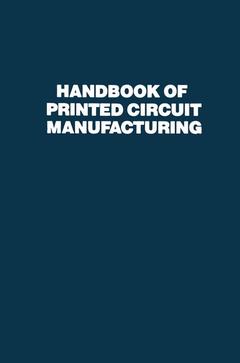Handbook of Printed Circuit Manufacturing, Softcover reprint of the original 1st ed. 1985
Langue : Anglais
Auteur : Clark Raymond H.

Of all the components that go into electronic equipment, the printed circuit probably requires more manufacturing operations-each of which must be per formed by a skilled person-than any other. As a shift supervisor early in my printed circuit career, I had to hire and train personnel for all job functions. The amount of responsibility delegated to my subordinates depended strictly on how well I had been able to train them. Training people can be a trying experience and is always a time-consuming one. It behooved me to help my workers obtain the highest degree of job under standing and skill that they and I were capable of. One hindrance to effective teaching is poor continuity of thought, for example, having to say to a trainee, "Wait a minute; forget what I just told you. We have to go back and do some thing else first. " It was in trying to avoid pitfalls such as this that I undertook a detailed examination of the processes involved, what I thought each trainee had to know, and what questions they would most frequently ask. From this analysis I developed the various process procedures. Only after I had done so was I able to train effectively and with the confidence that I was doing the best possible job. Answers had to be at hand for all of their questions and in what ever detail they needed to know.
Section 1. Design and Manufacture of Printed Circuits.- 1. How Printed Circuit Boards Are Manufactured: Processes and Materials.- What Is a Printed Circuit Board?.- What Is the Dielectric Substrate Made Of?.- The Manufacturing Process.- Bare Board Electrical Testing.- Dielectric Substrates.- 2. Computer Aided Design and Design Automation.- Using CAD.- Comparing Design Automation to CAD.- 3. Digital Printed Circuit Design.- Definitions.- Section 2. Planning, Document Control, and Quality.- 4. Definitions.- 5. Planning.- Planning Responsibilities.- Planning Procedures: Refer to Copy of Traveler.- Planning Order of Priority.- New Revisions.- Reorders.- 6. Quality Assurance Program.- Dealing with Customers and Product Returned by the Customer.- Underwriters Laboratories (UL).- Military Certification.- Summary.- 7. Quality Assurance Manual.- Elements of Quality Assurance 91 Calibration Program.- Inspection Stamp Control.- Inspection Supervisor Duties.- First Article Inspection.- Inspection Procedures.- First Inspection.- Final Inspection Procedure.- Processing Non-Conforming Product.- Processing Re-Works.- Military Specification Printed Circuits.- Processing of Returned Product.- Section 3. Imaging and Artwork.- 8. Artwork Processing.- Exposing.- Developing.- Definitions.- Customer Artwork Inspection.- Copy to Make Copies.- Step and Repeat (Using Diazo Containing Silver Film).- Soldermask.- Multilayer.- Repeats.- Spreads and Chokes.- Photo Supervisor.- 9. Artwork Registration Systems for Dry Film Imaging.- Pin Registration.- Visual Registration.- The Horning Pin Registration Method.- 10. Dry Film Imaging.- Micro-Etchants.- Compatibility With Other Processes.- Dry Film Lamination.- Exposure.- Cleanliness.- The Phototool.- Exposure.- Developing.- Solvent Developing Photoresist.- Spray Nozzles.- Solvent, Distillation, Reclamation, and Storage.- Fully Aqueous Resist 215 Special Considerations.- 11. Screen Printing.- Screen Printing Versus Dry Film Imaging.- What Is Screen Printing?.- Basic Components of a Screen Printing Operation.- Frames and Screen Materials.- Cleaning New Screens.- Ultraviolet Exposure Source.- Exposure Control.- Stencil and Screen Preparation.- Set-Up for Screen Printing.- Stripping the Screen After Use.- Automatic Screen Printers.- Plating Resists.- Soldermask.- Legend Resists.- Section 4. N/C Processing.- 12. Numerical Controlled Drilling and Routing.- Design Considerations.- Artwork Generation.- Artwork Inspection.- Drilling.- Numerically Controlled Routing Parameters.- References.- Acknowledgments.- 12A. Drilling Procedures.- Section 5. Plating and Other Wet Processes.- 13. Metal Thickness Determination.- Copper.- Tin-Lead.- Nickel, Tin-Nickel, Tin, and Silver.- Gold.- 14. Amperage Determination.- Geography of the Plating Pattern.- Bath Chemistry 292 Temperature.- Agitation.- Other Considerations.- Determining Amperage.- Method 1.- Method 2.- Method 3.- Notes.- 15. The Electroless Copper Process 300 Detecting Problems.- Drying Is Required.- The Need for Scrubbing.- Dwell Time in Copper.- Neutralize Caustic Residue.- Analyze Regularly.- Air Supply Required.- Think About the Board Being Processed.- Flash with Electroplated Copper.- Use Pump Agitation on Catalyst.- Keeping Fingerprints Off Panel Surface.- Rework Through Electroless Copper.- Troubleshooting Electroless Copper.- Analytical Information.- Procedures.- Maintenance Information.- How the Process Works.- 16. Pattern Plating: Copper, Tin-Lead, and Other Metals.- Daily Operating Routine.- Other Considerations.- 17. Contact Finger Plating.- Automatic Contact Finger Plating 367 Manual Contact Finger Plating.- Chemical Considerations.- Plating Tank Considerations for Contact Finger Plating.- Appearance of the Gold Deposit 381 Appearance of the Nickel Deposit.- Amperage Determination for Contact Finger Plating.- Contact Finger Plating Procedures.- 18. Resist Stripping.- Screen Printed Resists.- Photoresist.- Disposing of Spent Stripper.- 19. Etching.- The Challenges of Etching Today.- General Etching Procedures.- 20. Tin-Lead Fusing.- Hot Oil Reflow.- Problems.- Section 6. Multilayer Printed Circuits.- 21. Multilayer Processing.- General Processing Steps.- Planning the Construction of a Multilayer Printed Circuit.- Processing Operations.- Other Considerations.- 22. Etchback and Smear Removal.- Techniques for Etchback and Smear Removal.- Chromic Acid.- Sulfuric Acid.- Plasma.- Other Etchback Considerations.- Section 7. Process Control.- 23. The Laboratory.- Uses of the Laboratory.- Analytical Procedures.- Micro-Sectioning.- Setting Up Your Own In-House Laboratory.- Documentation.- Section 8. The Marketing Program.- 24. Sales Tools.- The Company Brochure and Advertisements.- The Product Line.- Certifications.- Personnel.- The Facility.- Suggested List of Sales Tools.- 25. What Sales People Should Know About Printed Circuits.- Processing and Materials.- Blueprint Reading and Difficulty Factors.- Mil-Spec Printed Circuits.- Bare Board Testing.- Appendix A: Yield Tracking: A Tool for Productivity.- Appendix B: CAD: Swift, Precise, Infinitely Repeatable, but Never Creative.- Appendix C: Soldermask Over Bare Copper: Alternatives and Manufacturing Techniques.- Appendix D: Control and Operation of Printed Circuit Plating Baths with the Hull Cell.- Appendix E: Troubleshooting the IR Fusing Process.- Appendix F: Preserving Solderability with Solder Coatings.- Appendix G: Screen Printing Is the Answer.- Appendix H: Forecasting Waste Treatment Requirements.- Appendix I: Wave Soldering of Discrete Chip Components.
Date de parution : 02-2012
Ouvrage de 620 p.
15.2x22.9 cm
Mots-clés :
© 2024 LAVOISIER S.A.S.



